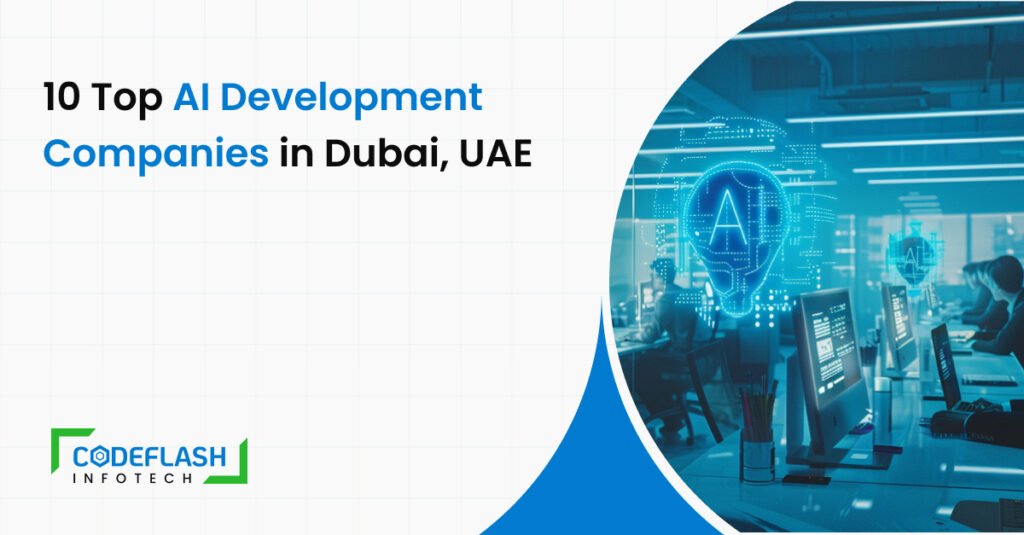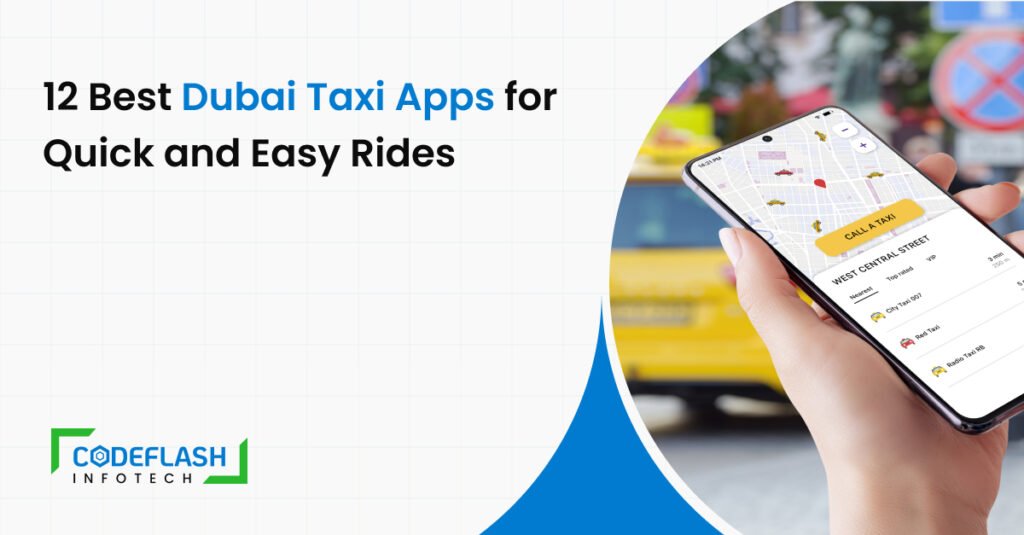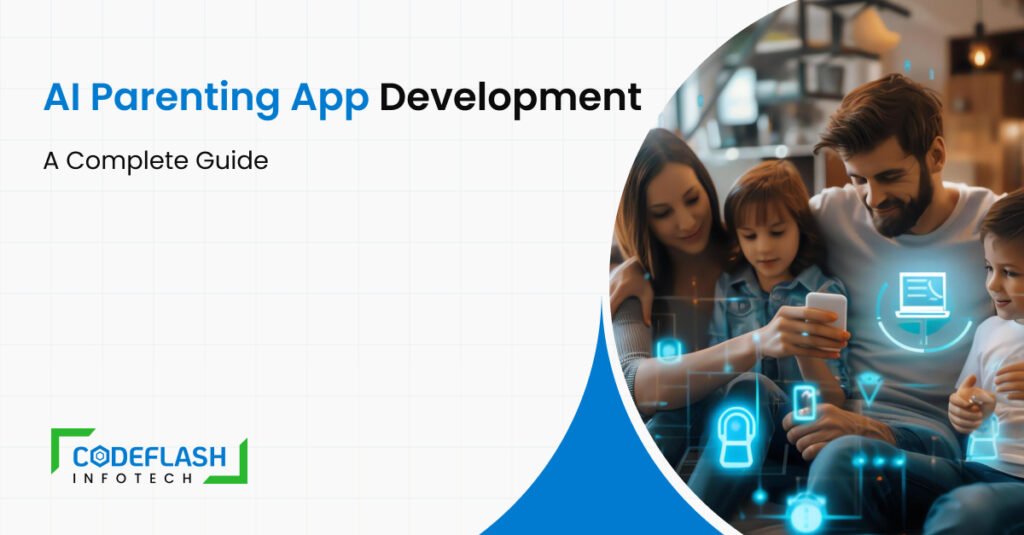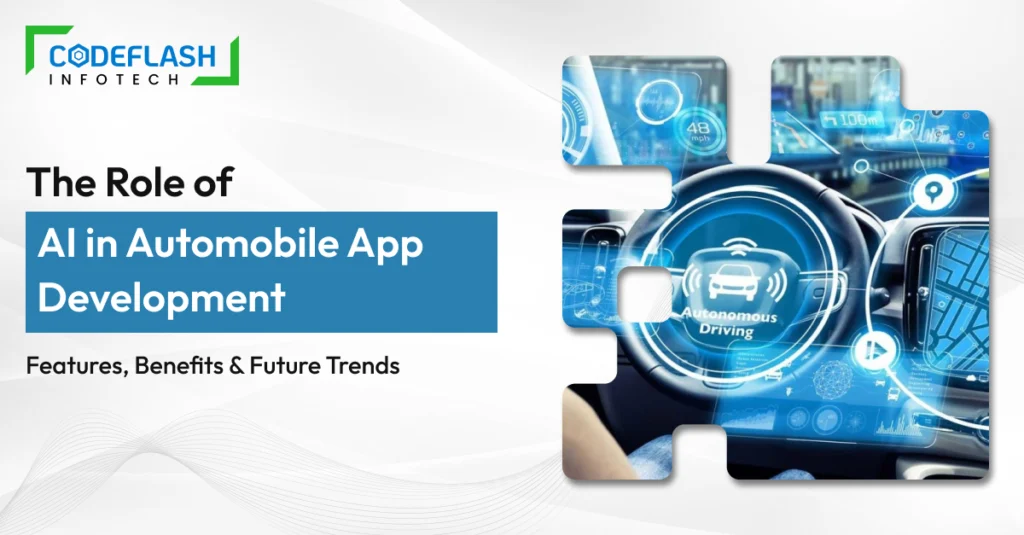
The Role of AI in Automobile App Development: Features, Benefits & Future Trends
05 August
Due to new technology, driving will be smarter and more connected than ever in the future. AI is transforming how people utilize automobiles in several ways, such as through smart infotainment systems and self-driving cars.
These apps are no longer just for finding your way; they are becoming smart co-pilots. Companies now put a lot of value on making AI-powered automotive apps that improve performance, safety, and the driving experience for each person.
As cars become more connected and self-driving, artificial intelligence is becoming more important in the automotive industry. The automotive industry uses it for everything from real-time driver assistance to problem diagnosis and repair.
In this blog, we have covered the role of AI in building smart vehicle apps, the benefits of AI in automotive mobile apps, how AI is used in automobile app development, and the steps to build an Automobile app development using AI.
Impressive statistics and innovative ideas are facilitating the rapid integration of AI into car apps. Statista says that by 2030, the global AI automotive market will have grown from $9.3 billion in 2021 to more than $70 billion.
According to McKinsey, AI-enabled features like smart infotainment, predictive maintenance, and self-driving cars could make up 20% of all auto software sales by 2030.
Tesla, BMW, and Mercedes already use AI-powered systems to regulate anything from personalized interior settings to autopilot. These patterns show that buying automotive AI app solutions is more than just being cutting-edge; it’s also about staying competitive in a market that is changing quickly.
How AI is used in automobile app development
- ADAS, or Advanced Driver Assistance Systems
The core of modern ADAS systems is artificial intelligence. These systems use lidar, radar, and cameras to look at data in real time, which helps with adaptive cruise control, avoiding collisions, and staying in your lane.
AI-powered car apps have dashboards that show real-time driving information, warnings, and suggested routes based on how the user drives.
- Predictive diagnostics and upkeep
AI systems look at sensor data from cars to figure out when parts are likely to break before they do. Fleet managers and car owners get real-time alerts from predictive analytics that help them save money on repairs and downtime. Smart car apps often show these insights using a user-friendly, interactive interface.
- AI assistants that can talk and listen
Voice-activated apps are changing how people use features in their cars. Natural Language Processing lets assistants like Cerence and Nio’s NOMI handle calls, navigation, air conditioning, and even mood lighting without drivers having to take their hands off the wheel. The use of AI enhances safety and directly contributes to smart car mobile app development.
- Personalization with Generative AI
Generative AI adds smart prediction and personalization. For example, a car app can play music that has been carefully chosen, change the climate settings to suit your needs, or automatically suggest routes based on your schedule.
The app learns from what you do over time and gives you a personalized experience that feels almost like a person.
- AI predicts traffic and helps you find your way.
This technology is used by car apps to make navigation more accurate by analyzing factors such as the weather, traffic patterns, road closures, and the driver’s history. Ride-hailing and logistics apps greatly benefit from this important tool, as it dynamically alters routes to provide users with alternative routes to avoid traffic.
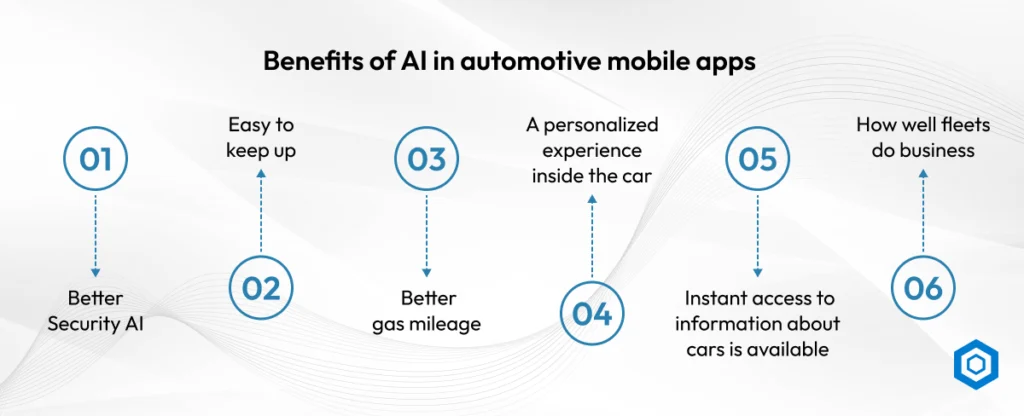
Benefits of AI in automotive mobile apps
As the demand for AI in automotive app solutions rises, developers and automakers are using AI to make mobile apps that connect users to their cars and actively improve safety, lower costs, and make driving more enjoyable. Here are some of the benefits of AI in automotive mobile apps:
- Better Security AI
helps ADAS systems make decisions in real time, which helps drivers avoid accidents, stay in their lanes, and respond quickly to changes in traffic. The mobile apps for these systems can let users know right away, which greatly lowers the chance of an accident.
- Easy to keep up
AI-powered predictive maintenance monitors the condition of worn-out parts and identifies early signs of failure to reduce unplanned breakdowns. Thanks to this, both customers and fleet operators save thousands of dollars a year on repairs.
- Better gas mileage
AI programs look at how you drive and suggest changes that could help you save gas. To help both financial and environmental goals, they can also plan routes that reduce engine load, idle time, and emissions in general.
- A personalized experience inside the car
AI learns what drivers like, including the music, the temperature, and how they sit in the car. As the system gets better at customizing the user experience, it automatically builds strong brand loyalty and user satisfaction.
- Instant access to information about cars is available.
You can now get real-time information about things like fuel levels, tire pressure, and battery health from apps. Modern customers are starting to expect these features more and more, and AI data processing makes it easy for them to work.
- How well fleets do business
Fleet operators find it easier to plan and get more done with centralized apps that use AI to monitor drivers, manage fuel, diagnose vehicles, and identify the best routes.
Read More: The Role of Artificial Intelligence in the Future of UI/UX Design
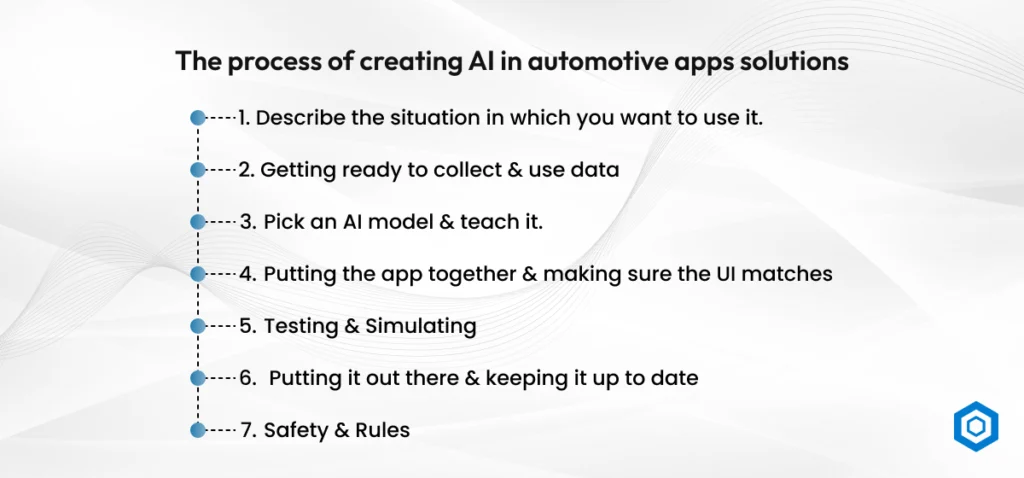
The process of creating AI in automotive app solutions
Step 1: Describe the situation in which you want to use it.
The first step in making an automobile app is figuring out what it will be used for. A well-defined use case helps make sure that the automobile app development using the AI roadmap, data strategy, and technology stack are all in sync, whether the focus is on real-time navigation, ADAS integration, predictive maintenance, or personalization in the car.
Step 2: Getting ready to collect and use data
After the goal is set, developers collect information that is important to the project, like how drivers behave, sensor input, voice commands, and maintenance history. Before you can use this data to train machine learning models, you need to clean, label, and organize it. The AI output is more useful and correct when the data is of better quality.
Step 3: Pick an AI model and teach it.
Depending on how complicated the use case is, the team developing automobile apps using AI either chooses pre-trained models or builds their own using tools like TensorFlow or PyTorch. Using gathered data, these models learn to spot patterns, make predictions, or respond intelligently to user input in real time.
Step 4: Putting the app together and making sure the UI matches
With TensorFlow Lite, Core ML, or ONNX, you may incorporate the learned AI models into the mobile app. Developers make sure that the AI works well with the app’s main features and that the UI makes it easy for users to see or interact with information without being too much.
Step 5: Testing and Simulating
After integration, the app undergoes multiple testing cycles. We test how the AI acts in different situations by putting it through real-world driving scenarios and simulated environments. This step makes sure that the software is safe, stable, and ready to use right away.
Step 6: Putting it out there and keeping it up to date
After passing all of the QA tests, the software is put out through OEM distribution or app shops. Over-the-air (OTA) updates are planned to make the AI work better over time. In future releases, the models will be retrained or improved using new data and user feedback.
Step 7: Safety and Rules
Privacy and data security are essential at all times. Developers need to make sure that data is stored securely, APIs are secure, and they follow rules like GDPR and CCPA. It’s important to be open about how you use data to build trust with users, especially in apps that track driving behavior or vehicle diagnostics.
How much does smart car mobile app development cost?
The cost of making an AI-powered car app can vary a lot based on how complicated it is, what features it has, how well it works with different platforms, and how well the AI is built in.
The price for a simple AI-enabled vehicle companion app with real-time tracking, the ability to lock and unlock the car from a distance, and maintenance alerts could start at $30,000 to $50,000.
The price range for mid-level apps that include features like voice assistants, predictive maintenance, and route optimization powered by machine learning is usually between $60,000 and $120,000.
If you are making full-scale, enterprise-level AI in automotive apps with edge AI processing, generative AI features, AR overlays, and high-level cybersecurity protocols, it could cost more than $150,000 to make and perhaps more than $250,000, depending on how much infrastructure and maintenance the app needs when it goes live.
Things like backend architecture, cross-platform development, data infrastructure, third-party API integration, and training AI models greatly influence the total investment.
Working with a skilled development company like Codeflash Infotech can help you cut costs and speed up the time it takes to get your product to market without losing functionality or scalability.
Read More: How Much Does It Cost to Hire A ReactJs Developer?
Trends in the future of AI app development for cars
Using Generative AI in vehicle apps will lead to the next big thing in technology. Soon, vehicle apps will work like co-pilots, giving you proactive suggestions, making personalized itineraries, and changing the driving environment based on how you feel or how worn out you are.
Edge AI will also be crucial for making smart car mobile app development. As cars get more powerful with built-in chips, they can run locally without having to wait for the cloud, which is important for things like safety alerts and offline navigation that need to happen right now.
Augmented Reality and AI together will change vehicle apps by putting overlays for live navigation, hazard warnings, and nearby points of interest right on the windscreen or the user’s phone. These immersive experiences will make it even harder to tell the difference between how people and machines move around.
Finally, AI regulations will influence how developers approach transparency, bias mitigation, and responsible data handling, ensuring that as apps get smarter, they also stay secure and compliant.
Conclusion
AI is not just transforming vehicles; it’s transforming how we build apps for them. AI is a key part of the next generation of mobility since it makes driving safer and easier and opens up new business models and ways to make money.
Now is the time to invest in automotive AI app solutions that are flexible, safe, and forward-thinking, whether you’re a startup trying to make a connected car app or a big company looking into making car apps with AI.
Companies that embrace new ideas early on will have an edge over their competitors as Artificial Intelligence in the automotive industry has become more common. Are you ready to make your smart auto app on your phone? With expert AI integration, user-focused design, and strong automobile app development using AI skills, Codeflash can help you make it happen.

Frequently Asked Questions
AI makes apps more responsive and useful by adding features like real-time decision-making, personalized driver experiences, predictive maintenance, and smart voice assistance.
It’s used in many different areas, like navigation, diagnostics, infotainment, security, and fleet management. Developers use AI models to make sense of data and give users automatic insights.
Better safety, lower maintenance costs, better fuel efficiency, a more personalized user experience, and more control over operations are all benefits for both consumers and businesses.
Yes. Generative AI in vehicle apps can make interactions more natural and efficient by allowing for smart trip planning, dynamic recommendations, context-aware voice responses, and predictive route changes.


